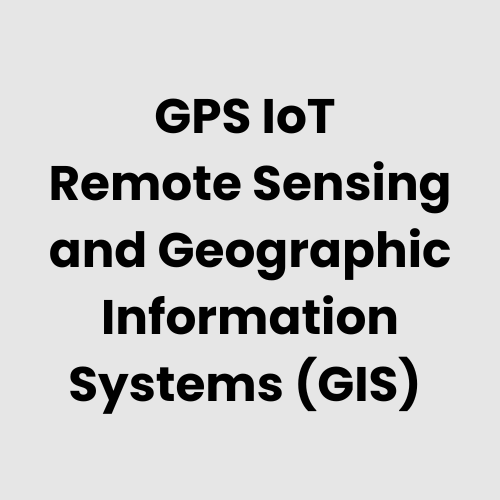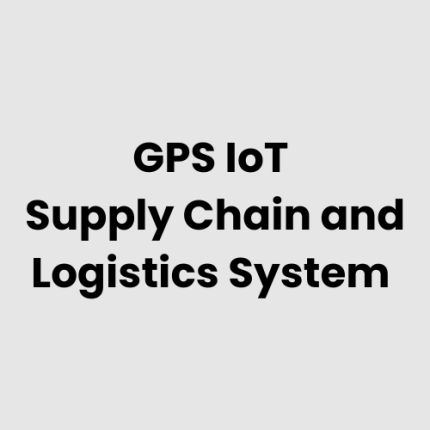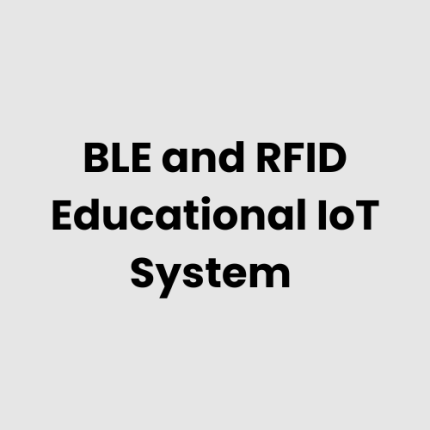GPS IoT Remote Sensing and Geographic Information Systems (GIS)
Explore the technical architecture, hardware, deployment, and data management of GPS IoT Enabled Remote Sensing and Geographic Information Systems by GAOTek.
Description
Technical Architecture of GPS IoT Enabled Remote Sensing and Geographic Information Systems
The GPS IoT Enabled Remote Sensing and Geographic Information Systems (GIS) integrate advanced GPS tracking, IoT sensors, and geospatial mapping software to provide real-time monitoring and data collection. These systems combine high-precision GPS coordinates with remote sensing technology to capture data from various sensors, including temperature, humidity, air quality, and other environmental factors. The system’s data is processed and visualized through GIS software, which integrates spatial data to offer actionable insights for decision-making.
Key Components:
- IoT Sensors: Collect environmental data from various sources.
- GPS Modules: Track the exact geographical location of the sensors.
- Data Transmission Modules: Relay data through cellular, satellite, or Wi-Fi networks.
- Cloud/Local Servers: Process, store, and manage collected data.
- GIS Software: Visualizes the data on interactive maps for real-time decision-making.
- User Interface: Allows for monitoring, reporting, and control via dashboards or mobile apps.
List of Hardware of GPS IoT Enabled Remote Sensing and GIS
- GPS Modules: Provide high-precision location data for tracking.
- Remote Sensing Sensors: Measure environmental factors like temperature, humidity, pressure, CO2 levels, and more.
- Data Transmission Devices: Utilize various network technologies (e.g., cellular, Wi-Fi, satellite) to transmit data.
- Edge Computing Devices: Perform localized data processing before transmission.
- Cloud or Local Servers: Process and store large amounts of collected data.
- Geospatial Mapping Systems: Software tools that visualize and analyse data in map form.
- Power Supply Units: Provide necessary power to IoT sensors and devices.
- Enclosures and Mounting Hardware: Protect and secure devices in harsh outdoor environments.
Physical Placement Considerations of Hardware for GPS IoT Enabled Remote Sensing and GIS
The physical placement of hardware is essential to ensure the accurate collection of data and optimal system performance. Some key placement considerations include:
- Sensor Placement: Sensors should be placed in representative locations to capture a wide range of environmental data. They should be mounted at appropriate heights for temperature, air quality, or other measurements.
- GPS Signal Reception: GPS modules must be placed where they have clear visibility of the sky to ensure accurate location tracking. Avoid placement under heavy obstructions like buildings or dense tree canopies.
- Power Supply: Ensure power supply devices (e.g., batteries or solar panels) are positioned to ensure consistent power for extended periods, especially in remote locations.
- Environmental Protection: Sensors and hardware must be placed in weatherproof enclosures to prevent damage from exposure to rain, dust, or extreme temperatures.
- Network Coverage: Ensure the devices are placed in areas with reliable network connectivity (e.g., LTE or satellite) for data transmission.
Hardware Architecture of GPS IoT Enabled Remote Sensing and GIS
The hardware architecture of the GPS IoT Enabled Remote Sensing and GIS system involves the integration of multiple layers of technology working together seamlessly:
- Sensing Layer: This includes various IoT sensors that detect environmental data such as air quality, temperature, and moisture. These sensors are connected to GPS modules for precise location tagging.
- Data Collection Layer: The data collected by the sensors is transmitted via data transmission modules, such as cellular modems, Wi-Fi, or satellite communication. Edge computing devices may also process data locally before transmission to reduce latency and bandwidth use.
- Communication Layer: Data is sent through secure communication protocols (e.g., MQTT, HTTP) to cloud or local servers for processing. The communication layer ensures that data is transmitted reliably.
- Processing Layer: This layer involves processing the incoming data, performing analytics, and applying GIS algorithms. It often involves using cloud servers or high-performance local servers that aggregate data and prepare it for visualization.
- Visualization Layer: The data is then visualized on geospatial mapping platforms where it is shown on interactive maps, allowing users to monitor, analyse, and make decisions based on real-time data.
Deployment Considerations of GPS IoT Enabled Remote Sensing and GIS
- Environment Assessment: Analyse the environment where the system will be deployed to determine sensor type, location, and placement to ensure optimal data collection.
- Power and Connectivity: Ensure reliable power sources (solar panels, batteries) and consistent communication networks (cellular, Wi-Fi, satellite) for remote locations.
- Scalability: Consider the need to scale the system for large geographical areas or additional sensors, ensuring the architecture can support expansion.
- Data Privacy and Security: Implement security protocols to protect sensitive data during transmission and storage.
- Integration with Existing Infrastructure: The system should be easily integrated with existing GIS platforms, remote sensing equipment, and data management systems.
- Maintenance and Monitoring: Plan for regular system maintenance, updates, and monitoring to ensure that sensors and devices remain functional over time.
List of Relevant Industry Standards and Regulations
- ISO/IEC 27001: Information security management.
- IEEE 802.15.4: Wireless communication for low-rate personal area networks.
- ITU-T G.8110.1: Standards for IoT applications.
- ISO 9001: Quality management systems.
- ISO/IEC 20000-1: IT service management.
- NIST SP 800-53: Security and privacy controls for federal information systems.
- FCC Regulations: Wireless communications compliance.
- IEEE 802.11: Wireless networking standards.
- WMO Guidelines: World Meteorological Organization standards for remote sensing and environmental data collection.
- GDPR: General Data Protection Regulation (for handling sensitive data in the EU).
Local Server Version (Running with a Local Server)
For applications where data processing needs to remain within the local network, the GPS IoT Enabled Remote Sensing and GIS system can be deployed using a local server. This server collects and processes data locally before sending reports to a centralized location, offering benefits such as:
- Data Security: Data stays within the local infrastructure, minimizing risks of data breaches during transmission.
- Low Latency: Processing data locally reduces delays in decision-making by eliminating the need for long-distance data transmission.
- Customization: Custom configurations can be tailored to meet specific organizational requirements without relying on external cloud infrastructure.
- Resilience: Even in areas with unreliable internet connectivity, a local server can continue operations and store data for later transmission.
Cloud Integration and Data Management
The cloud integration for GPS IoT Enabled Remote Sensing and GIS systems offers powerful data processing and storage capabilities. Key features of cloud integration include:
- Data Aggregation: Collects data from remote sensors, providing centralized storage and management.
- Scalable Storage: Cloud services provide scalable storage options to handle vast amounts of environmental data over extended periods.
- Real-Time Access: Provides stakeholders with real-time access to data and analytics through dashboards or mobile applications.
- Data Analytics and Visualization: Cloud platforms enable advanced analytics, such as machine learning and AI-driven insights, as well as real-time geospatial visualization.
- Security: Implementing encryption and access control mechanisms to ensure the security of data in transit and at rest.
- Integration with Other Systems: Seamlessly integrates with other business and operational systems, enhancing decision-making and automation capabilities.
By leveraging cloud computing, GAO Tek Inc. ensures that the GPS IoT Enabled Remote Sensing and GIS system can offer high availability, ease of access, and robust data management capabilities while maintaining data security and compliance with industry standards.
GAO Case Studies of GPS IoT Enabled Remote Sensing and Geographic Information Systems
USA Case Studies
- New York City, NY
In New York City, the GPS IoT Enabled Remote Sensing and GIS system was deployed to monitor environmental conditions across urban areas. The system tracks air quality, traffic congestion, and temperature variations, providing real-time data for city planning and emergency response. GAO Tek’s solution enhances the accuracy of environmental monitoring for urban development.
- Los Angeles, CA
Los Angeles implemented a GPS IoT-enabled system to assess soil moisture levels and water usage in agriculture. By combining GPS data with remote sensing, the system provides farmers with insights into irrigation needs, optimizing water resource management and reducing waste. GAO Tek’s solution supports sustainable agriculture practices in the region.
- Chicago, IL
In Chicago, a GPS IoT-based remote sensing system was installed to monitor the health of local forests and green spaces. The system tracks temperature, humidity, and soil health, providing essential data to city planners for sustainable urban development and environmental conservation. GAO Tek’s solution assists with proactive management of the city’s green infrastructure.
- Houston, TX
In Houston, GAO Tek’s GPS IoT solution enabled real-time monitoring of flood-prone areas by tracking water levels and environmental conditions. The data is integrated with GIS platforms to offer immediate insights for emergency response teams during flood events, improving decision-making and safety for residents.
- Miami, FL
Miami used GPS IoT technology to monitor the coastline for signs of environmental degradation and coastal erosion. Remote sensors collect data on water quality, salinity, and temperature, which is then processed through GIS to predict trends and inform conservation efforts. GAO Tek’s system aids in protecting vital coastal ecosystems.
- San Francisco, CA
A GPS IoT-enabled system was deployed in San Francisco to monitor traffic patterns and urban mobility. Sensors placed on roads and intersections collect data on traffic flow, which is analysed and visualized through GIS. This data helps the city optimize traffic management and reduce congestion. GAO Tek’s solution improves urban planning and efficiency.
- Seattle, WA
Seattle implemented a GPS IoT system to monitor air pollution levels across industrial and residential areas. Using real-time data, environmental agencies can track the effects of pollution on public health and develop policies to mitigate risks. GAO Tek’s technology enhances environmental monitoring capabilities in the city.
- Denver, CO
In Denver, the GPS IoT-enabled system is used for wildland fire prevention and monitoring. The system tracks temperature, humidity, and vegetation conditions, sending real-time alerts to local authorities when risks increase. GAO Tek’s technology supports proactive wildfire management strategies in mountainous areas.
- Phoenix, AZ
Phoenix deployed a GPS IoT solution to manage urban heat islands and optimize energy use in buildings. The system tracks heat patterns across the city, and data collected helps adjust urban cooling strategies to reduce energy consumption and improve air quality. GAO Tek’s system contributes to sustainable urban design.
- Washington, D.C.
In the nation’s capital, GPS IoT systems monitor traffic and environmental conditions around major federal buildings and areas of interest. The integration of real-time data with GIS assists government agencies in making informed decisions related to traffic control, environmental sustainability, and urban planning.
- Boston, MA
In Boston, the system is used to track weather patterns, including snow accumulation, temperature, and precipitation. This data is processed through GIS to aid in municipal snow removal and maintenance. GAO Tek’s solution allows the city to respond more efficiently to winter weather challenges.
- Atlanta, GA
In Atlanta, GAO Tek’s GPS IoT solution is used for infrastructure maintenance by monitoring the condition of bridges and roads. Sensors detect vibrations, movement, and environmental factors, providing data that helps the city prioritize repairs and avoid major infrastructure failures.
- Portland, OR
Portland implemented GPS IoT sensors to monitor forest fires in remote forest areas. These sensors provide real-time temperature, smoke, and wind speed data, which is integrated with GIS software to predict fire spread and aid firefighting efforts. GAO Tek’s technology is vital in managing fire safety in vulnerable regions.
- Dallas, TX
Dallas deployed a GPS IoT-enabled system to monitor air and water quality across the city. The system tracks pollutants and provides real-time data to environmental authorities for better policy formulation. GAO Tek’s solution plays a key role in managing environmental health and public safety in urban areas.
- Las Vegas, NV
In Las Vegas, GAO Tek’s GPS IoT system is used to monitor desertification and water usage. Sensors track soil conditions and weather patterns, feeding data to GIS platforms that assist in managing water resources for agriculture and urban areas. GAO Tek helps optimize water conservation efforts in arid environments.
Canada Case Studies
- Toronto, ON
Toronto deployed a GPS IoT-enabled system for monitoring urban heat islands and tracking environmental factors such as temperature, humidity, and carbon dioxide levels. This data, integrated with GIS, assists city planners in making informed decisions about green spaces, urban development, and sustainability.
- Vancouver, BC
Vancouver uses a GPS IoT-enabled system to monitor coastal areas for signs of rising sea levels and environmental changes. Sensors collect real-time data on water levels, salinity, and temperature, which is then processed through GIS to predict trends. GAO Tek’s solution is helping the city prepare for climate change-related challenges.
Navigation Menu for GPS IoT
- GPS IoT Trackers/Devices
- GPS IoT Tracking Accessories
- GPS IoT Tracking Resources
- GPS IoT – Cloud, Server, PC & Mobile Systems
Navigation Menu for IoT
- LORAWAN
- Wi-Fi HaLow
- Z-WAVE
- BLE & RFID
- NB-IOT
- CELLULAR IOT
- GPS IOT
- IOT SENSORS
- EDGE COMPUTING
- IOT SYSTEMS
Our products are in stock and can be shipped anywhere in the continental U.S. or Canada from our local warehouse. For any further information, please fill out this form or email us.
We are actively looking for partners who are like us located in the U.S. and Canada. For more information on partnering with GAO, please visit Partner with GAO Tek Inc.It lists various ways to partner with GAO, such as OEM Partnerships, Technology Integration, Distribution and Reselling Opportunities, Presenting at the Leading Event Tek Summit, Joint R&D Projects, Training and Consulting Services, Industry-Specific Collaborations, Research and Academic Partnerships.



